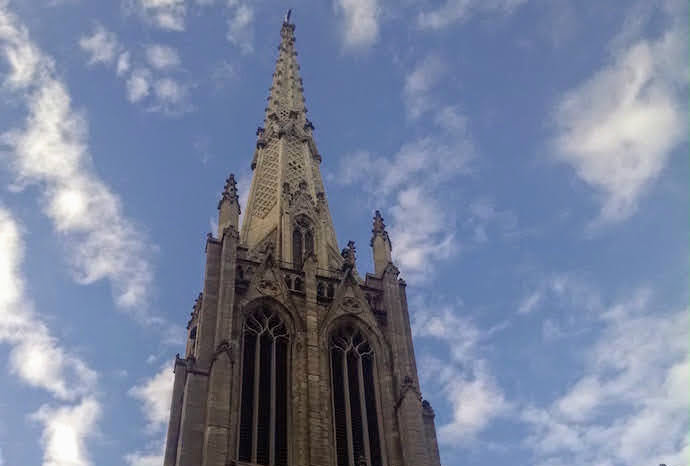The delicate and graceful Grace Church is one of the most beautiful structures in town. The earliest example of Gothic Revival architecture in New York City, it was the very first commission of James Renwick Jr., who went on to design St. Patrick’s Cathedral and earn his place as one of America’s most prominent architects.


The site selected for the church was part of Henry Brevoort Sr.’s family-owned land parcel and apple orchard that once stretched from Washington Square to Union Square. When it came time to lay out the city’s famous grid of streets according to the commissioner’s plan of 1811, 11th Street was supposed to cut through the farm and uproot Brevoort’s favorite tree. Brevoort responded by protecting his lot with an actual live bear chained to a tree meant to scare anyone daring to approach. According to a less romantic version of the story, Brevoort was a lawyer and protected his lands through more traditional means. In any case, the commissioner backed down, the farm stayed intact and, as a result, 11th Street runs interrupted between Broadway and Fourth Avenue. This location, one of the few places in the city where the grid system is disturbed, eventually served as a lot for the church.

The Episcopalian Grace Church congregation was the creme-de la-creme of society, consisting of the wealthiest New Yorkers. The rector of the church took the task of the new church construction very seriously; after traveling through Europe to examine famous churches, he decided that he wanted his church to be designed in the Gothic style. Despite the multitude of bids submitted by established designers from around the city, the commission was granted to James Renwick Jr. —a 24-year-old civil engineer without any prior experience. Not only did James Renwick Jr. have no architectural training nor experience designing a building, but he had never even seen a Gothic church before! He held an engineering degree from Columbia University, and his only prior job experience consisted of working on the construction of the Croton Reservoir at 42nd Street. But he studied every book on Gothic architecture in order to come up with a proposal suitable to his client’s needs. It worked in his favor that he came from a cultured and highly educated family, and it certainly didn’t hurt matters that Henry Brevoort happened to be his uncle.


Made out of marble (a very expensive material that was only rarely used for churches) and looking amazingly light and delicate, Grace Church stands as a testament to raw architectural talent. It’s also credited with initiating the Gothic Revival architecture trend in New York and remains widely admired.
It’s hardly important anymore that James Renwick Jr. had landed the job with some help from family members.
- Address: 802 Broadway, New York
- Architect: James Renwick Jr.
- Function: Parish church
- Spire height: 230 feet (70 m)
- Years built: 1846–1847
- Denomination: Episcopal Church

Leave a Reply